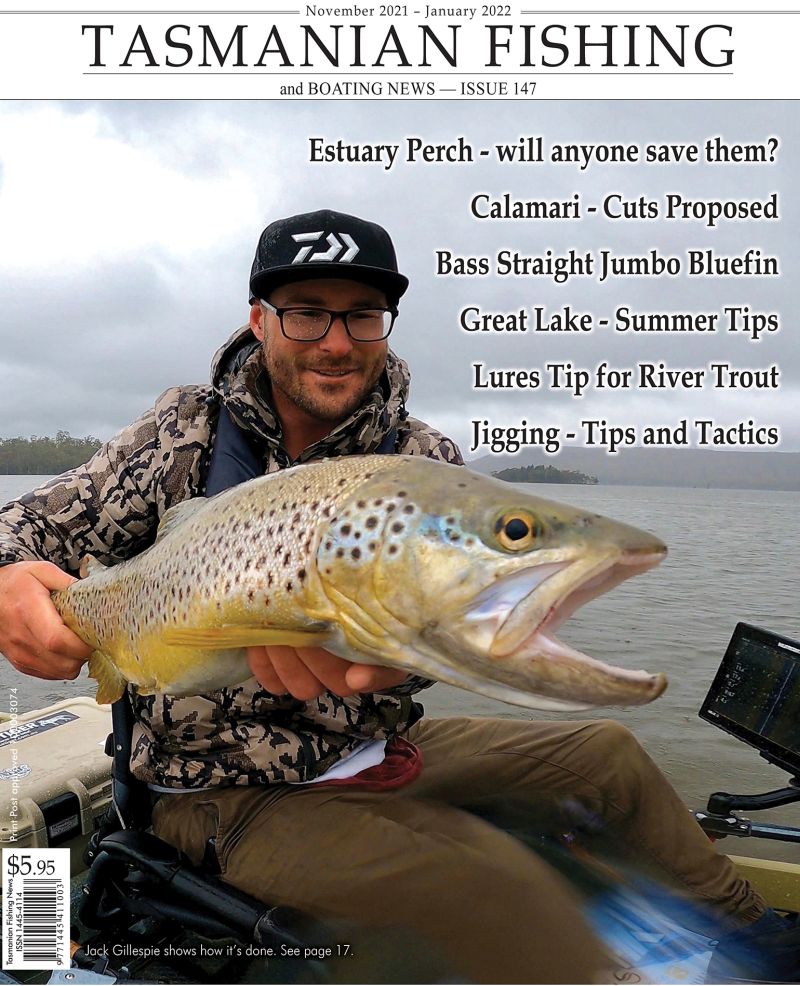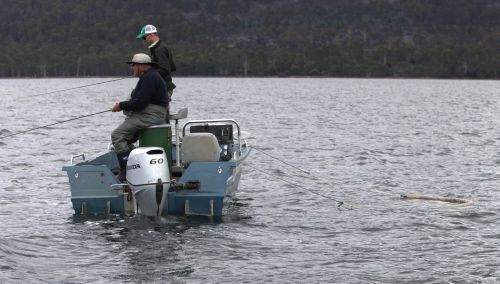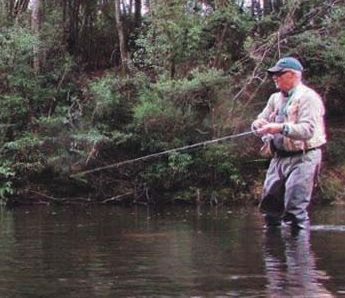 Presented from Issue 111, August 2014
Presented from Issue 111, August 2014
Well another season is upon us once more and early season fishing can run hot and cold for this time of the year. With the season start still being in Winter we are still going to have quite a bit of inclement weather to put up with for a month or two. Cold, windy and wet days at times making fishing conditions very hard and every fish well earned for those who tough it out.
Then there will be the very clear, cold frosty mornings when the temperature is so low that the water from the line freezes in the rod eyelets preventing one from retrieving the line back in after a few casts with the lure. For those of us who love trout fishing rivers, well that’s just something we take in our stride. Remember to be well rugged up, that’s the main thing, and really you don’t have to get up and be on the water at first light this early in the season either. Well I don’t any way, I start around 9.00 am and still get a good catch on most trips.
Early season trout fishing can be very rewarding with many nice plump trout being taken by both bait and lure fishing rivers. The rivers may be running high and dirty, or they could be running medium and reasonably clear giving us the choice of bait or lure fishing. It all boils down to how much rain we get during this early part of the season.
Bait Fishing
For me it will depend on how much rain we’ve had and if they’re high and dirty, then it will be bait fishing. I’ll be sitting back on a river bank with two rods set in a backwater with a bunch of worms on the hooks. I love the start of the season when the rivers are high and I can do a bit of bait fishing as it is so relaxing. One can sit back and enjoy the beauty that surrounds us while waiting for that fish to eventually take the bait. It’s even better on a clear sunny and calm Winter’s day too.
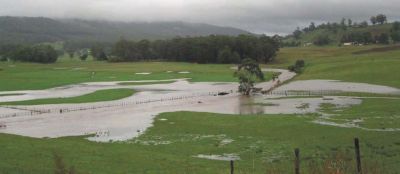 |
| Flooded rivers are great for bait fishing early in the season. A garden worm is often all that is needed. |
When bait fishing high water always look for a backwater, flooded paddock or a very slow flowing pocket of water close to the river bank. Trout will be feeding on worms that have been washed into rivers or drowned in flooded paddocks. This is where you will catch most fish in these conditions. I have caught several very nice browns in some of the smallest calm pockets of water close to the river bank, so always flick a baited hook into those areas when you come across them. The one thing you must have when bait fishing is patience and plenty of it. Patience will be rewarding for you in the long run that’s for sure. I have sometimes picked up a fish before I’ve had a chance to get my second rod in the water. Other times I’ve sat there for two hours before picking up a fish, but that’s how bait fishing goes. I often throw some soil with a few worms mixed in with it out into the river and then flick the baited hook out to that area. This regularly results in a catching a few browns by doing this as well. Most times I have my baited hooks sitting no more than 6 metres from the bank. The trout won’t be any further out than that as the flow is too strong.
The set up I use is a small ball or bean sinker (around 8 gms) set above a swivel, followed by a 600 – 800mm trace with a size 6 bait holder hook and a nice bunch of gardens worms on it. Once you’ve flicked your bait out, let it sink to the bottom, flick the bail arm over and loosen off the drag so the fish can pick up the bait and move off without feeling any resistance. Then place your rod onto a rod holder or push a Y-shaped twig into the soft ground and rest you rod in the top of the Y. Then it’s just a matter of sitting back and waiting for a bite.
Please do not use any willow twigs and branches for your rod support as these will shoot and grow if left in the ground. Some bait fishers will leave the bail arm open and place a small stone on the line so when the fish takes the bait the line pulls free from the rock. The same basics also apply if the rivers are running high and clear too. You just have to remember the water is very cold and the trout will be slowing moving around feeding as not to waste energy. They will be solid well condition fish, and you can expect to pick up fish around the 1 kilo mark or better.
With flooded paddocks, you should fish much lighter with the sinker (or none at all) as the water will be much shallower than the river, and you will often see trout tailing in these areas. There are many rivers that fish well once the water flows over the river banks and into the paddocks. The Leven and Macquarie rivers are just two of them that fish extremely well when this occurs. So there you have it, try a bit of early season river bait fishing whether the water is dirty or clear, give it a go and enjoy the moment. It’s also good as family outing, and a great way to get the kids started in fishing rivers for trout. Remember to leave the area as you found it when you arrived to fish, please take you rubbish home with you.
Lure Fishing
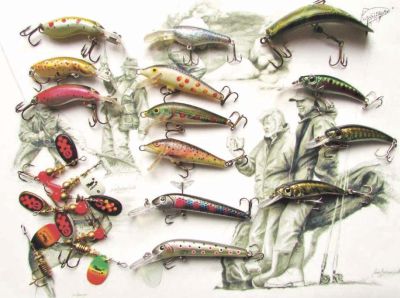 |
| A selection of the author’s lures. |
Lure fishing early in the season can be a frustrating time when spinning for trout as their metabolism is low due to the very cold water. Cold, fast flowing water and sluggish trout can make for several trying trips. This is when I look to fish the slower sections of river because early in the season trout will rarely be taken in fast water.
They will be along the edges of the river banks and in the slower runs just off the main flow of the river, waiting to pounce on anything that passes by. They will be holding deep in the areas that will be energy saving for them. When using blade spinners and with the water being so cold it pays to use a bright coloured lures (silver or fluoro) as this will help to stimulate the fish and get them to strike the lure. If the river is running high then it is advisable to work the lure from the river bank and not take any chances of being in the river chasing them. The river bottom is normally very slippery early on in the season, and it’s just not worth risking your life getting into a fast flowing river even though it may look okay to you. This is where rivers that flow through open pastures are great to spin from and there are plenty of rivers like this around Tasmania that are accessible too. Remember, if they are not one that has the Angler’s Access set ups on them, then please contact the land owner to gain permission to enter the property. Just because you have a trout license, it doesn’t give you the right to enter a property without the owner’s consent.
Whether you are using a hard body lures, soft plastics or blade spinners make sure they are bright coloured ones as I stated earlier, it will stimulate the trout into striking the lure. Cast the spinner up and across the flow, then keeping the rod tip at around 45 degrees let the lure drift with the flow and slowly retrieve the line as to keep the slack out of it. Give the rod a light twitch every now and then, by doing this it you will have a better chance of a strike and a hook up. Continue this method as you slowly work your way upstream along the river bank. Always look ahead of to see if there are pockets of near still or slow water along the river bank, and if there is cast directly upstream and work the lure down through it.
These pockets of water will often give up a trout as well. If you come across a run of slow water amongst some trees and there is ample room to flick a lure, then do so. These areas can and do hold some nice solid fish in them. If the water is cloudy or even a little dirty then use a dark (I would recommend black with fluoro dots) coloured lure. A dark colour shows up more to the trout in these conditions than a bright lure.
When I do decide to have a decent few hours of spinning in a river I’ll normally go for a smaller river or stream rather than tackle the bigger rivers. Though I still hit the bigger rivers at least once or twice a week and have a session. With the smaller rivers they seem to settle down much quicker than the large rivers and I can get in and wade them in safety. It pays to have a set of thermal underwear and socks on too, as the cold water really hits home. You have to remember that early season spinning for trout in rivers will be much slower until the weather warms up and the water temperature rises to a suitable temperature for them. I still work the rivers the same way early in the season as I do throughout the whole season.
The only difference is the clarity of the river, water temperature and the lure colour. I do up my blade spinner size in the larger rivers at this time of year too because of the extra river height. Whereas I normally fish a #00 (1.5gm) spinner I go to a #1 (3.5gm) spinner as it will run much deeper.
Then there’s the hard body lures, a sinking or suspending lure is my preferred choice only because of the rivers being much higher and trout will be holding deeper at this time of year.
There are plenty of very good hard body lures available now days so pop into your local tackle shop and pick up a few. Talk to the sales staff if you are unsure of what lure you looking for, they will only be too happy to help out. Once you’re on the river it’s only a matter of casting them out and working the lure in much the same way as using the blade spinner. Only different thing I do is to not let it drift with the flow. I will work the hard body lure from the time it hits the water. On the retrieve I will flick the rod from side to side. This helps to give the lure a little more action as you work it through the water. Remember it’s up to you to get that trout stimulated into striking the lure.
When using a hard body early in the season I normally stick with a rainbow pattern or a silvery (shiny) coloured models as these have always worked well for me. Fishing cold water with lures can often be a lot of trial and error. Don’t be afraid of changing your choice of lure at all, especially if you haven’t had a strike. A change of lure may just result in getting your first trout for the season. Once the river levels have dropped to a safe wading height, then get into them and start working those lures and spinners hard. Your catch rate should now improve as you will be able to cover more water with the lures. Just remember, do not take any risks as no fish is worth drowning for.
So whether you’re going to start the season off with a hook full of juicy fat worms, or are going to flick a lure around, remember the main thing is to enjoy the time spent on a river chasing trout with the family, friends or a mate.
Adrian Webb


